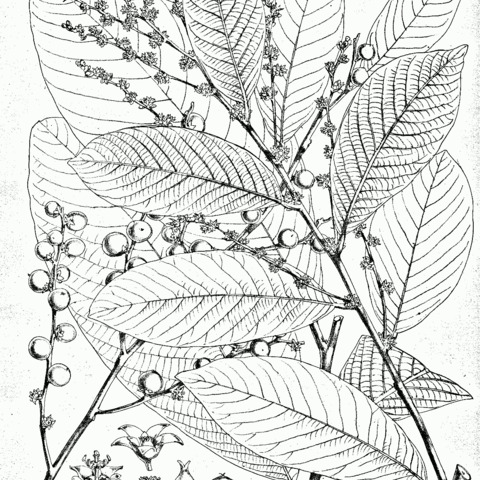Shrubs or trees, rarely lianes, evergreen or rarely deciduous, perennial, dioecious or rarely monoecious; stems and foliage without obvious latex. Indumentum of multicellular uniseriate trichomes; stinging hairs absent; glandular hairs absent. Stipules entire or rarely divided, inconspicuous, caducous. Leaves alternate, petiolate, elobate, entire or weakly sinuate or dentate, penninerved, not glandular. Inflorescences axillary, glomerulate, bracteate. Male flowers sessile or shortly pedicellate; calyx lobes 5, valvate, partially connate at base; petals 5, alternate with sepals; disc present between the reproductive parts and the perianth, pulvinate and fleshy; stamens 5, with filaments united into short column with upper parts free; anthers basifixed or dorsifixed, bilobate, with thecae oblong to ellipsoid, longitudinally dehiscent; pistillode topping the staminal column. Female flowers sessile to shortly pedicellate; perianth and disc as in male flowers, but with an additional inner, membranous disc that surrounds the ovary; ovary 2-or 3-locular; ovules biloculate; styles 2, free or united at base, bifid. Fruits drupaceous, ellipsoid to globose, with surface smooth, indehiscent. Seeds 1 or 2 per fruit; ovoid to semi-ovoid; testa smooth; albumen fleshy or membranous; ecarunculate; cotyledons broad, flat.
Trees, shrubs, rarely woody lianas. Leaves simple, alternate, entire, pinnately veined, petiolate, stipulate. Flowers small, unisexual, monoecious, few to many flowers grouped into axile glomerules, pedicellate or sessile. Sepals 5, valvate. Petals 5, scale-shaped. Male flowers: stamens 5; filaments connate at base, forming staminal column, apical free and extended filaments surrounding rudimentary ovary; anthers dorsifixed, introrse, 2-loculed, parallel, longitudinally dehiscent; rudimentary ovary terete or obovate, sometimes conical, 2-4-fid at apex; disk cup-shaped or discoid. Female flowers: disk pulvinate or saucer-shaped lining flower with a conical or urceolate part, surrounding ovary, tearing as ovary expands; ovary 2-loculed; ovules 2 in each cell; styles 2, free or connate at base, bifid or entire at apex. Drupes or rarely capsules with fleshy epicarp, 1-or 2-celled (putamens). Seeds 1 or 2, with longitudinal groove; embryo curved; endosperm copious; cotyledons thin, large. x = 13.
Male flowers in many-flowered fascicles, sometimes with 1–2 female flowers admixed, sessile, subsessile or shortly pedicellate; sepals (4)5, valvate; petals 5, small, inflexed and not contiguous or imbricate; disk annular or cupuliform, entire or sinuate; stamens 5, filaments united below into a short column, free and spreading above, anthers horizontal, basifixed, the thecae parallel, longitudinally dehiscent; pistillode at the top of the column ampulliform, entire or 2–4-lobed.
Seeds solitary per locule by abortion, plano-convex and longitudinally grooved in 2-locular fruits, C-shaped in transverse section and hollowly cylindrical, split down one side in 1-locular fruits; albumen copious, fleshy; embryo curved; cotyledons broad, foliaceous, thin.
Female flowers few per cluster or solitary, sometimes pedicellate; sepals and petals perigynous, otherwise ± as in female; outer disk annular, inner encasing the ovary; ovary 2(3)-locular, ovules 2 per locule; styles 2(3), free or connate at the base, bifid or subentire.
Leaves alternate, shortly petiolate, stipulate, simple, entire or more or less so, penninerved; lateral nerves straight, arched or looped, tertiary nerves usually parallel.
Fruit drupaceous and indehiscent or else dehiscent; exocarp thin; mesocarp fleshy; endocarp crustaceous, 1-or 2-locular.
Flowers small, axillary, glomerulate or fasciculate, sometimes in spikes or panicles of glomeruliform fascicles.
Trunk and branches sometimes armed with blunt thorns.
Monoecious, or rarely dioecious shrubs or trees.
Bracts small, scale-like.
Indumentum simple.

